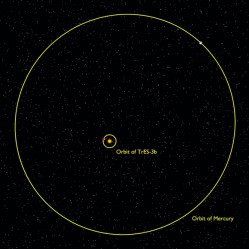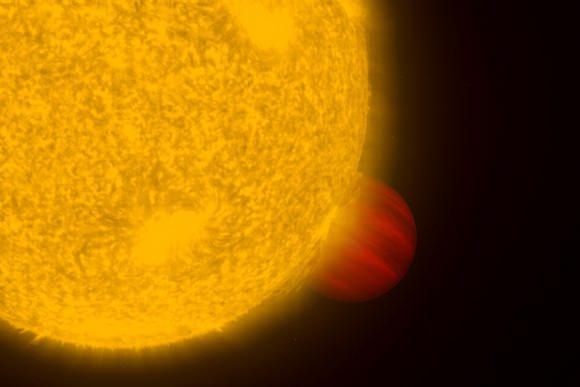[/caption]
For the first time, astronomers have measured light emitted from extrasolar planets around sun-like stars using ground-based telescopes. The observations were obtained simultaneously and independently by two separate teams for two different planets. Incredibly, they were also able to determine properties of the exoplanets’ atmospheres as well. Measuring the light emitted from a planet at different wavelengths reveals the planet’s spectrum, which can be used to determine the planet’s day-side temperature. In addition, this spectrum can reveal many physical processes in the planet’s atmosphere, such as the presence of molecules like water, carbon monoxide and methane, and the redistribution of heat around the planet. “This first direct detection of light emitted by another planet, using existing telescopes on the ground, is a major milestone in the study of planets beyond our own Solar System,” said Professor Gary Davis, Director of the United Kingdom Infrared Telescope (UKIRT). “This is a very exciting scientific discovery.”
The measurements of the first planet, TrES-3b, were conducted by a team of Astronomers from the University of Leiden, using the William Herschel Telescope (WHT) on La Palma (Canary Islands, Spain) and the United Kingdom Infrared Telescope on Mauna Kea in Hawai`i. TrES-3b is in a very tight orbit around its host star, TrES-3, transiting the stellar disk once per 31 hours. For comparison, Mercury orbits the sun once every 88 days. TrES-3b is just a little larger than Jupiter, yet orbits around its parent star much closer than Mercury does, making it a “hot jupiter.”
UKIRT observations caught the planet transiting in front of the star, from which the size of the planet has been worked out extremely precisely. The WHT observations also show the moment the planet moves behind the star, and allow the strength of the planet light to be measured. Astronomers have been trying to observe this effect from the ground for many years, and this is the first success.
Ernst de Mooij, leader of the research team, said, “While a few such observations have been conducted previously from space, they involved measurements at long wavelengths, where the contrast in brightness between the planet and the star is much higher. These are not only the first ground-based observations of this kind, they are also the first to be conducted in the near-infrared, at wavelengths of 2 micron for this planet, where it emits most of its radiation.”

The researchers determined the temperature of TrES-3b to be a slightly over 2000 Kelvin. “Since we know how much energy it should receive by the type of its host star, this gives us insights into the thermal structure of the planet’s atmosphere,” added Dr. Ignas Snellen, “which is consistent with the prediction that this planet should have a so-called ‘inversion layer.’ It is absolutely amazing that we can now really probe the properties of such a distant world”.
An atmospheric inversion layer is a layer of air where the normal change of temperature with altitude reverses. Current theory says that there are two types of “hot jupiters,” one with an inversion layer, and one without. One theory is that the presence of an inversion layer would depend on the amount of light the planet receives from its star. If the inversion layer could be confirmed, for example by measurements at other wavelengths, these observations would fit in perfectly with this theory.
A second team has made a ground-based detection of a different extrasolar planet, OGLE-TR-56b,using the Southern Observatory’s Very Large Telescope. This planet is about 5,000 light-years away, located towards the center of the galaxy. The planet is quite hot; its atmosphere is more than 4,400 degrees Fahrenheit (2,400 degrees Celsius). This is one of the hottest extrasolar planets detected.
The researchers say both landmark observations will open up a new window for studying exoplanets and their atmospheres using ground-based telescopes, and show great promise for using future extremely large telescopes which will have much higher sensitivity than the telescopes used today.
Paper for TrES-3b.
Paper for OGLE-TR-56b
Source: Joint Astronomy Center


The TrES-3b link doesn’t point to the paper (yet), but you can find a preprint here.
5,000 light years away is close to the galactic centre? Last I heard the galactic centre is somewhere around 25,000 light years away. “In the direction of the galactic centre” perhaps?
Andy-
Yes, it should be “towards the center” and so I’ve updated the text.
Thanks.
The results look to be based only on thermal heating. Recently the Cluster satellites discovered (confirmed) that the Earth and Sun are connected by “magnetic ropy structures”, in other words, spiraling electric (ions + electrons) currents. We also note the Jupiter/Io flux tube measured at a millon amperes. It seems predictable that a giant planet so close…deeply embedded, really…in the host star’s plasmasphere, will exhibit strong electromagnetic coupling with the star. That would change the energy balance and so I wonder if the researchers have plans to include this consideration in the theory governing the energy balance.
Any chance that large Earth-bound observatories, HST or Spitzer may be able to unambiguously detect elements or hi-temp compounds in the atmospheres of these planets? I realize that disentangling these complex spectra will not be easy, but is it now possible to do so (however crudely), or will this have to await larger ground-based telescopes or the likes of the Webb Space Telescope? Expanding on B Davis post above, would large radio telescope networks (VLBI comes to mind) be of any use with objects of this type? Could a radio interferometers’ extremely high resolution be of any use, if not to chemically characterize atmospheric constituents, than to provide other useful properties of these transiting exoplanets (e.g. precise orbital predictions, magnetic fields (if any), debris disks, planet and atmospheric densities and more precise temperatures, etc)?